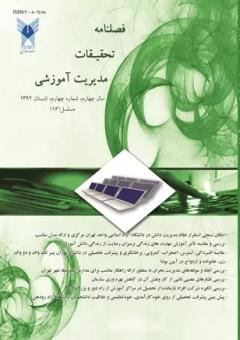طراحی الگوی تربیت شهروندی بر اساس اسناد بالادستی
محورهای موضوعی : مدیریت آموزشیسحر بختیاری 1 , نجمه وکیلی 2 * , مهشید ایزدی 3 , مهدی دوایی 4
1 - گروه علوم تربیتی،دانشگاه آزاد اسلامی،واحد تهران مرکزی،ایران
2 - گروه علوم تربیتی،دانشگاه آزاد اسلامی،واحد تهران مرکزی،ایران
3 - گروه علوم تربیتی،دانشگاه آزاد اسلامی،واحد تهران مرکزی،ایران
4 - گروه علوم تربیتی، دانشگاه آزاد اسلامی، واحد تهران مرکزی،ایران
کلید واژه:
چکیده مقاله :
هدف پژوهش حاضر، طراحی الگوی تربیت شهروندی بر اساس اسناد بالادستی است و این پژوهش از نظر هدف بنیادی - کاربردی و از نظر نوع کیفی است. دادههای موردنیاز به روش اسنادی و با رعایت اصل اشباعشدگی از میان پنج سند تحول بنیادین آموزشوپرورش، برنامه ششم توسعه، منشور حقوق شهروندی، الگوی اسلامی ایرانی پیشرفت و برنامه درسی ملی گردآوریشدهاند. تربیت شهروندی در جامعه بشری بخصوص کشور عزیزمان ایران به آن شکلی که نیاز است توجهی به آن نشده ویکی از موارد لازم و ضروری در جهت رشد و پیشرفت جامعه تربیت شهروندی است. پس برای تدوین الگوی تربیت شهروندی، اسناد مورد تأیید کشور بالاخص 5 سند مورداستفاده در این پژوهش بسیار مناسب است. روش تجزیهوتحلیل دادهها، کدگذاری از روش تحلیل مضمون و طی شش گام به روش براون کلارک انجام شد. در بخش یافتهها مؤلفهها و زیرمؤلفههای تربیت شهروندی بر اساس اسناد بالادستی، بامطالعه و تحلیل اسناد و مدارک علمی موجود استخراج شدند. الگوی تربیت شهروندی شامل چهار مؤلفه اصلی (بعد اجتماعی - بعد فرهنگی - بعد سیاسی و بعد اقتصادی) و 19 زیر مؤلفه (احترام به قانون و لزوم رعایت آن، بالابردن امکان انجام کارهای گروهی و مشارکتی، ارزشهای اجتماعی مرتبط بااخلاق و...) که در پژوهش فوق به طور کامل لیست شد الگوی تدوین شده مناسب به جهت ارائه آن به مراکز آموزشی، مدارس و بهویژه معلمان است.
The purpose of the current research is to design a model of citizenship education based on upstream documents, and this research is fundamental-applicative in terms of purpose and qualitative in terms of type. The required data have been collected by documentary method and in compliance with the principle of saturation from among the five documents of the fundamental transformation of education, the sixth development plan, the charter of citizenship rights, the Iranian Islamic model of progress and the national curriculum. Citizenship education in the human society, especially our dear country Iran, has not been paid attention to as it needs to be. So, for developing the model of citizenship training, the documents approved by the country, especially the 5 documents used in this research, are very suitable. The method of data analysis, coding was done by thematic analysis method and in six steps by the Brown-Clark method. In the findings section, the components and sub-components of citizenship training were extracted based on the upstream documents, by studying and analyzing the available scientific documents. The citizenship education model includes four main components (social dimension - cultural dimension - political dimension and economic dimension) and 19 sub-components (respect for the law and the need to comply with it, increasing the possibility of doing group and collaborative work, social values related to ethics, etc.) which was completely listed in the above research, the prepared model is suitable for presenting it to educational centers,schools and especially teachers.

